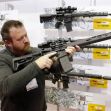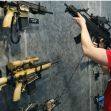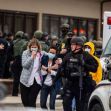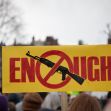A Northwestern Medicine study has been published in a pre-print and is waiting to be accepted by a journal. For now, it is preliminary. The study found that the Federal Assault Weapons Ban (FAWB) that existed from 1994-2004 led to a large decrease in mass shootings and the number of gun injuries and deaths.
The study determined how many mass shootings the ban prevented and how many shootings could have been prevented had the ban stayed in place. According to the study’s authors, the study prevented about 10 mass shootings and would have prevented 30 mass shootings that killed 339 people and injured 1,139 more. The study defines mass shootings as four or more deaths in a single public space.
“It does not result in fewer other types of gun deaths and injuries, such as domestic homicides. You only need one bullet to commit suicide, kill your wife or kill somebody else. But when you are just looking at mass shootings, it is super effective,” said Lori Post, director of the Buehler Center for Health Policy and Economics at Northwestern University Feinberg School of Medicine.
Assault weapons are often used for mass shootings due to their ability to fire a large number of bullets. “The purchase of the assault weapon is often the final step in the preparation and execution of a mass shooting,” Post said. “The shooter from Colorado bought his assault weapon and ammunition one week before the mass shooting.”
50,000 people die each year from gun injuries. Less than 1% of gun deaths occur as a result of mass shootings. However, there have been studies that show that about one-third of adults avoid public spaces because they are afraid of a mass shooting.
Mother Jones’s definition of a mass shooting is three or more deaths in a public space. From 2007-2017, Mother Jones’s database found that there were 495 people killed in mass shootings. About half of these deaths (253) occurred as the result of a person with an assault weapon. For that same time period, the FBI's annual crime reports show 150,352 total homicides. Out of these deaths, 103,391 deaths involved a firearm. Therefore, mass shootings using assault weapons were only involved in 0.17 percent of all homicides and 0.24 percent of firearm homicides. In 2017, there were 1,590 people murdered with a knife or sharp instrument
There were 261 people murdered in mass shootings with assault weapons from 2014-2019. This is an average of 52 murders annually. At this rate, it would take about 30 years of mass shootings with assault weapons to reach one year’s worth of knife deaths.
A Department of Justice study said that the 1994-2004 ban on assault weapons had no evidence of curbing gun violence and that “should it be renewed, the ban’s effects on gun violence are likely to be small at best and perhaps too small for reliable measurement.”
In 2019, the Journal of General Internal Medicine looked over gun control policies from state to state and concluded there was no statistical correlation between assault weapon bans and homicide rates. A study done by the Journal of the American Medical Association (JAMA) came to the same conclusion.
Post thinks that now that the election and COVID-19 are no longer a big part of the news cycle that more mass shootings will now occur. “The previous news cycles sucked the oxygen out of mass shooters as they are looking to be newsworthy,” Post said. “Now there is room on the national agenda for mass shooters.”
Many different studies have been done on the effectiveness of the assault weapons ban, but no conclusion has been reached on whether or not it worked.






